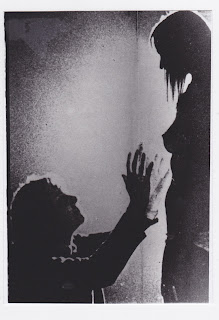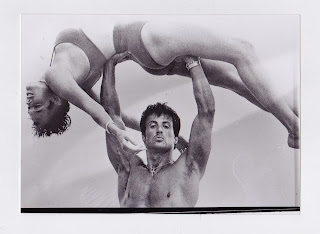For my independent project I decided to continue on from
last year as I felt like I had a lot more angles to experiment with. I started
off doing a lot of research into different artists, after doing my research
project I had a lot more knowledge of ‘appropriation’ and realised how relevant
it was to my project. It occurs a lot with found photography as the images are
often used and recycled to portray a different meaning. I then researched a lot
more into found photography, and realised it was quite widely used for a
variety of reasons and wanted to continue using images I had found myself. This
is when I decided to search for negatives over the internet as I found it
interesting that with using negatives I wouldn’t know what I would be getting
and this could prove quite challenging. I ending up receiving film stills from
a couple of different movies, which was quite interesting as I was expecting
generic family, or travel images. At
first however this seem quite problematic as most of the images were well known
shots from popular films and I wanted to take the images out of their original
context. I did in the end chose two with
interesting contents and where not film specific. I wanted to make a piece in
response to Barbra Krugers work, however I wanted to highlight the fact that I
did not agree with the gender stereotypes that are shown a lot in the types of
films where my images came from. That’s why I layered an obvious stereotype in
text over the images and then manually stuck quotation marks over the top.
After these pieces I did more research and tried some more different angles of
layering words over images, firstly with found words and my own images, and
thirdly with my own words over my own images. Towards the end of my project I
started to research more into whether words or images can represent the real
life more accurately. However I only just touched on the surface. I think that
my project is still unfinished due to the large subject I chose, there where so
many avenues to go down I didn’t have enough time to experiment with them all
to finish with one final piece or outcome. But I do still think its interesting
enough to continue the project in the future. I think I have experimented
enough with found photography and hopefully will be moving on to using
different techniques such a Jenny Hozler inspired projection or larger scale
images covered in words. Over all I am happy with the work I have produced so
far, but have a lot more to investigate until I come to a solid conclusion. My favourite outcome was the experimentation
with my found negatives as I feel I had successfully got to grips with the use
of appropriation and discovered how photographs can be edited in ways to
completely change the image intentions and meanings.
INDEPENDENT PROJECT
Thursday, 28 March 2013
After researching into Alexander Honory's work of using words to represent pictures it started to get me thinking about which medium of representation is more truthful. Which is when I constructed this image. I decided to take the same concept but instead of removing the image altogether I wanted to integrate both ideas into one. I printed off loads of words and physically covered them over the object they were describing. This was my way of investigating what is more trustworthy the words or the images? Here I have not been too descriptive with my truth of words because it is only a basic background.
Thursday, 7 February 2013
Alexander Honory
Each photographic image holds a moment, a fraction of the past that holds and proves the existence of its author, the object within and the owner. By finding and re-presenting images like these artists like Alexander Honory are saving that moment in time and the memory from eternal destruction and symbolically restoring the presence of the people/objects within them. Where as Schmid takes a more physical approach to recycling images in order to help the environment, Honory uses a more 'spiritual' way to present his art. His method on re-producing the images he finds and reconstructing the meanings is through presentation. He uses enlargement, framing ect to highlight the human within the image, giving the common 'family photograph' individuality. He likes to respect his subjects and authors by not only bringing back the images but focusing on the entirety of the moment in which it was taken. For example in his work "Thirteen newlywed couples for Berlin", he projected giant wedding images in the town centre of Berlin to take a private intimate photograph and re-present it in the most public way possible. In the mid 90's he then started to question the significance of photography within family memories. He would write a description of what was missing out of the photograph and present the words in the gallery instead of the images, this work was called "The Lost Pictures". This work was widely open to interpretation, where Honory was actually portraying his disbelief in the power of photography. Controversially although he is a photographer, he struggles to believe that photography is able to describe what images really represent. This work reflects the pieces I made in the first year, layering words over the images questioning which medium best represents what happened at the time.
Finding words first
Wednesday, 6 February 2013
Ed Ruscha – Word Paintings
Ruscha is an American artist who worked with a variety of
medias including painting, printing, photography and illustration around the
Pop Art movement. His art training was
based around commercial photography which introduced his interest in typography
and using words within images. His first
works included oil paintings with comic writing layered over the top referring
to popular culture. He once spoke about
where his phases come from: “Well,
they just occur to me; sometimes people say them and I write down and then I
paint them. Sometimes I use a dictionary.” I find this really interesting, and
so far have worked using images first and then finding words to overlay them,
however I am now thinking about starting with words then finding images after
and see what a different effect this has on the work outcome. Ruscha has always
used different means to add words onto his images, for example pouring liquid
over a flat monochromatic surface, this is something I would have really liked
to have tried in my project, bringing in more of an ‘art’ factor into my work
however at this point it is not a path I could take with the time scale I have
but will hopefully something I can practice in the future. I also like the way
Ruscha makes connections to his words outside of his images, for example a
project in which he presented seven different words that rhymed, and in a
separate project he did a series of images with “dirty” and inviting phrases.
This sort of play on words it what attracted my attention to his works. However
there is an ongoing theme throughout his work, even if it is sometimes not so
obvious, Rushca is constantly asking questions about the impact urban life has
on society.
Friday, 1 February 2013
Reusing images
Next I wanted to add words to my found images in the style of Kruger. Out of the negatives I chose these two images because they contradict each other, portraying the male gender of both weak and strong. Looking through Krugers work I have seen that she emphasises these stereotypes. However I wanted to make fun of them, trying to portray the point that not all men are physically strong or mentally week. This is why I used the language "man strong" and "man weak", because grammatically it makes no sense, therefore mocking the meaning. To emphasise my point I also used quotation marks to show that they are not my personal opinions but those of socialists such as Kruger. I also used paper on top or a darkroom print and brown tape to stick it down to experiment with how montage would look. Technically when enlarging the prints in the dark room I did have to do a bit of dodging and burning on both images, however because of the poor quality on the negatives or the original photograph that was taken the quality of the prints were not 'technically' pleasing. However from the beginning I said that because I had no control over the negatives themselves, the image quality out come wasn't important, making it conceptual.
Thursday, 31 January 2013
Subscribe to:
Comments (Atom)













